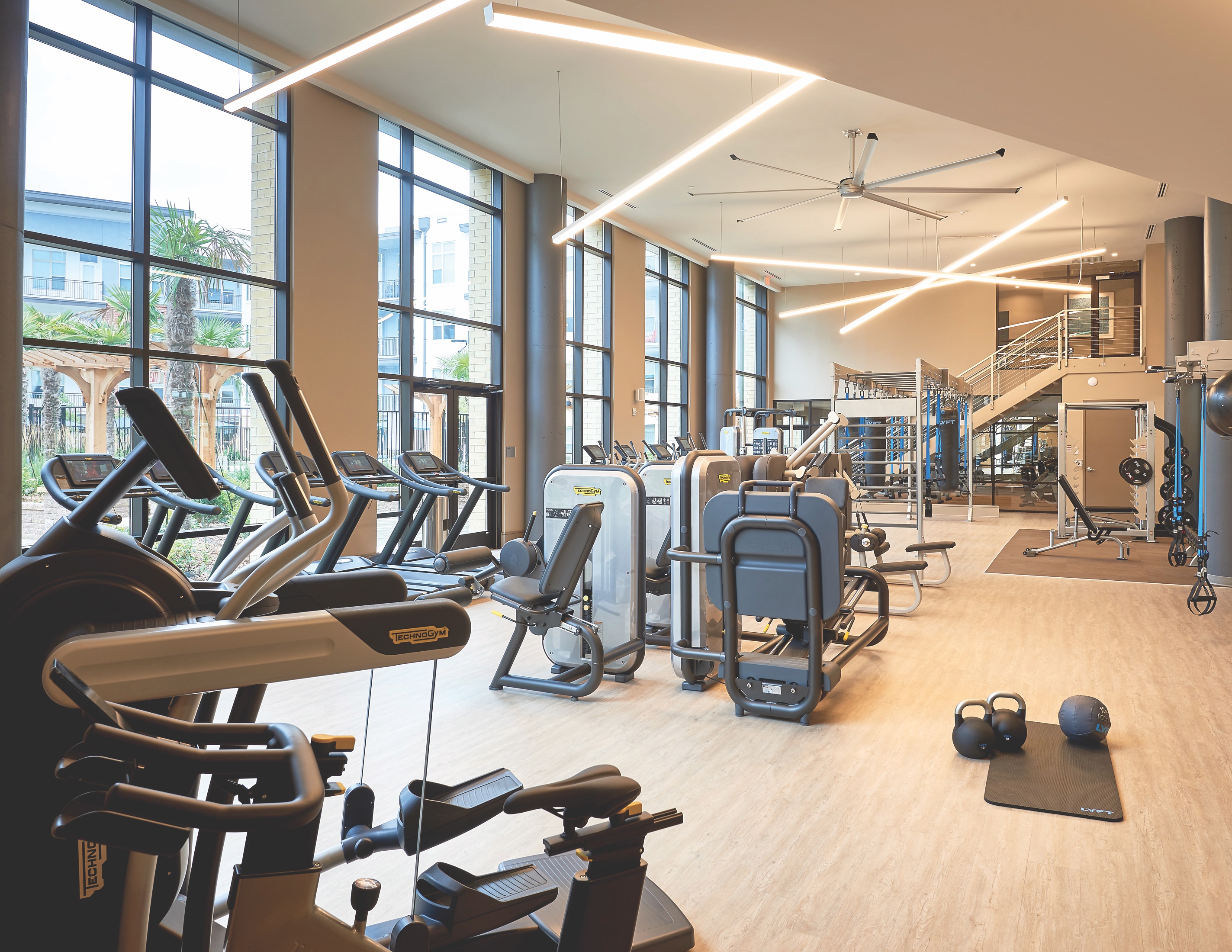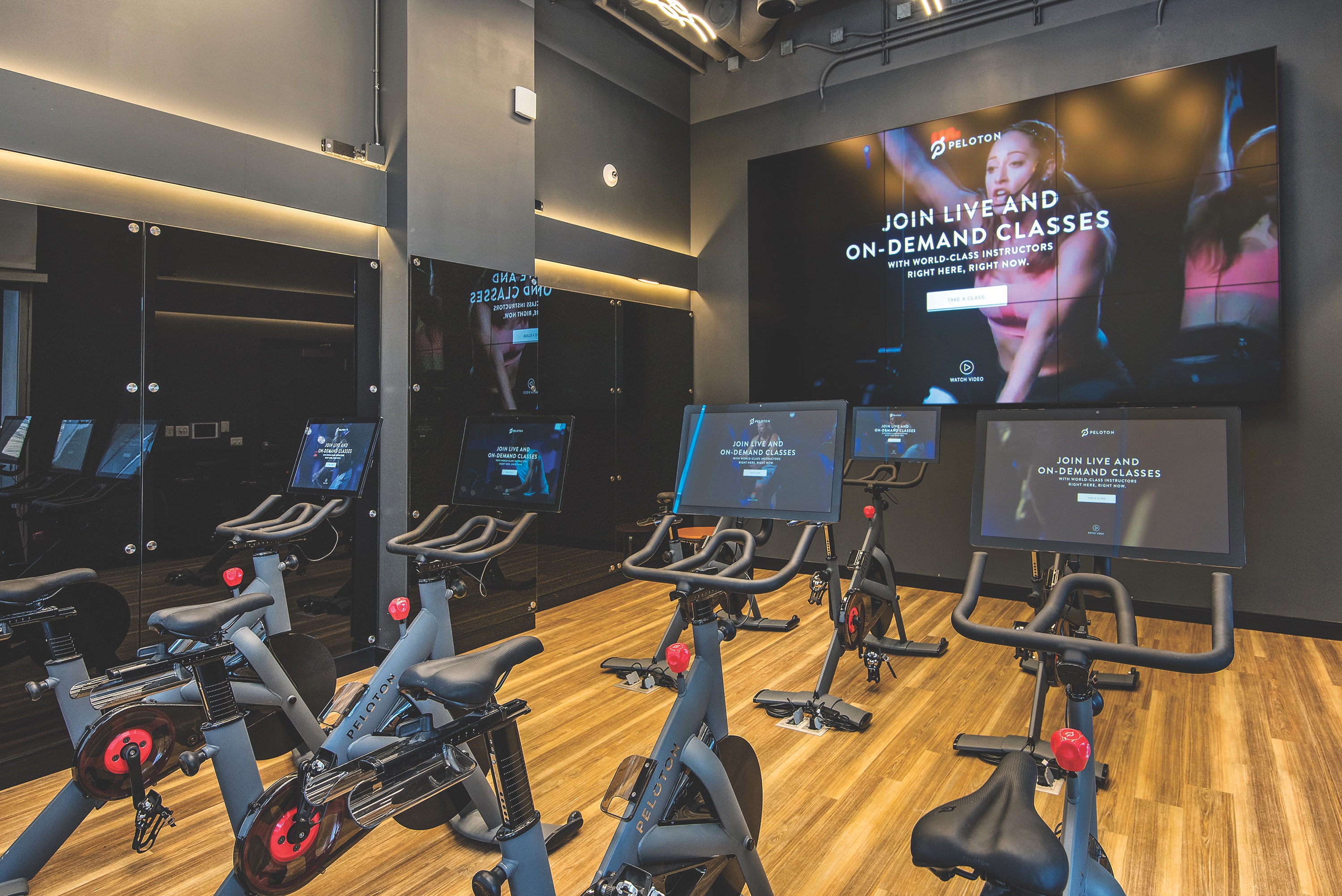With two-story windows facing an outdoor Olympic-sized pool, the fitness center at the Inspire Southpark apartment complex in Charlotte, N.C., is a stunning showpiece. It’s no accident the 4,350-sf fitness facility is located right near the leasing office. The developers, Bond Companies and Morgan Holdings, view amenities, especially fitness, health, and wellness facilities, as central to the appeal of their multifamily properties.
“We actually design around the amenity spaces,” said Ryan Morgan, Project Manager with Morgan Holdings. “We’re trying to establish communities with micro-experiences.” Inspire Southpark, along with the 366-unit Spoke Apartments, in Chicago’s River West area, caters to active adults who want a variety of exercise options.
Morgan said he sees some multifamily developers building fitness centers “just to check a box.” That won’t work with Millennials, many of whom grew accustomed to top-notch fitness facilities in college. Baby Boomers, too, are committed to fitness, health, and wellness.
An October 2017 survey by the National Multifamily Housing Council and Kingsley Associates found that 55% of renters said they would not sign a lease in an apartment building that lacked a fitness center.
Fitness facilities offer multifamily dwellers expedience and value, said Rob Bond, President, Bond Companies. “If we can save someone a half-hour by not having to commute to a health club, that’s a real convenience,” he said. This is especially true if the facility matches or exceeds the local upscale fitness spa and is free to tenants.
Creating a stellar fitness center often requires the skills and expertise of an outside design consultant. “We’ll never be as good at it as the people who do it all day long, every day of the week,” Bond said.
Fitness equipment distributors and fitness facility designers can advise on sizing, configuring, and outfitting fitness centers. Karl Smith, DHEd, Director of Residential Well Living for developer Cortland, typically seeks bids from three leading fitness equipment distributors when designing fitness facilities for a new apartment complex. Engaging with these firms is a great way to stay current with fitness trends, what competitors are offering, and how your next multifamily offering can differentiate itself in the fitness realm, he said.
Correctly sizing the space for the number and type of residents is crucial. For Bond, the rule of thumb is at least 10 sf of fitness space per dwelling unit. When planning new properties, Cortland, which owns 137 rental properties in 21 markets, uses a formula that includes average number of adults per unit and the percentage of those projected to be regular gym users. In renovations, the size of the fitness area is usually restricted to the existing space, said Smith, but on rare occasions it may be possible to knock down a wall to gain more space.
New and renovated fitness areas should have a minimum of two distinct areas—one for strength training and cardio equipment, another for classes such as Zumba, Nia, Pilates, and yoga. Ideally, the classroom space should be in a dedicated room; where closed-off space is not feasible, providing open space within the strength/cardio area is an alternative. Cortland specifies a minimum of 500 sf to be allocated for open class space. Some properties provide residents free classes as an incentive.
 Inspire Southpark, Charlotte, N.C., has a wellness center with vaulted ceiling, indoor/outdoor yoga rooms, and a WELLBEATS spin room. The adjacent spa offers nail services, massage therapy, and a sauna. A 25-meter pool and one-acre private park add to the property’s health and wellness theme. Photo: Dustin Peck Photography.
Inspire Southpark, Charlotte, N.C., has a wellness center with vaulted ceiling, indoor/outdoor yoga rooms, and a WELLBEATS spin room. The adjacent spa offers nail services, massage therapy, and a sauna. A 25-meter pool and one-acre private park add to the property’s health and wellness theme. Photo: Dustin Peck Photography.
A well-designed fitness center should have a space set aside for functional training—exercises that allow individuals to perform the activities of daily life more easily and without injuries. Functional training is a hot trend for both young adults and those over 50. Millennials gravitate toward vigorous activities using gear such as infinity ropes, heavy bags, pull-up bars, and jump targets. For seniors, functional training means lighter activity using dumbbells, stability balls, balance boards, and the like. “People 60 and over are not into the fad aspect of fitness and wellness,” Smith said. “They’re looking for functionality, ease of use, safety, and time efficiency.”
Both Cortland and Bond/Morgan properties provide equipment with fitness-on-demand training capability. Touch-screen kiosks on Cortland fitness center walls offer 600 classes on demand. Cortland surveyed 600 tenants and found that 71% said yoga would be their top choice for active play, followed by kickboxing (56%), boot camp (52%), Zumba (50%), and spinning (46%). Dead last: running clubs.
Cortland relies on design consultants to ensure its fitness spaces not only are ADA compliant but also to “make sure every piece of equipment can fit in the fitness center the way we need it to,” Smith said. Certain pieces of equipment can’t be placed next to mirrors, as their movement could cause the equipment to collide with the glass.
“The goal used to be to throw a lot of equipment into the fitness center,” Smith said. “Now it’s more about the functionality and openness of the layout.” Smith said it’s important to have not only enough equipment but also the right mix of equipment so as to minimize waits. For example, most people use cardio equipment such as stationary bikes for longer periods than they use strength-training equipment. So you need to be aware of the typical turnover time on the equipment you order.
See Also: Topsy-turvy: Creative use of air rights results in a model of urban luxury design
In designing new fitness spaces, keep in mind high ceilings, large windows, and proper lighting. LED tape that can change colors is a great way to set moods, said Morgan. The choice of music must also fit the activity—soothing tones for yoga, upbeat tunes for spin classes. Bright wall colors are usually best for active areas, while more subdued hues are preferable for meditation and yoga spaces.
Flooring also varies according to use. “For yoga, you want a somewhat squishy floor,” meaning resilient flooring, Morgan said. Floors in strength and cardio spaces should be firm.
To some, it may seem like spending considerable effort and resources on fitness amenities is wasteful, but that NMHC/Kingsley survey found that 82% of renters said they’re at least “interested” in a fitness center when choosing an apartment community.
“We think we’re getting payback from the value proposition of our amenities,” Bond said. “The idea is to get residents thinking, ‘I’m living in a luxury community, why would I want to live anywhere else?”
Related Stories
| Aug 11, 2010
Oldcastle Precast Building Systems wins PCI 2009 Sustainable Design Award
Oldcastle Precast Building Systems was part of the award winning team behind the affordable housing development Melrose Commons Site 5 situated in the South Bronx. PCI (Precast Concrete Institute) recently selected Melrose 5 for the “2009 PCI Design Award for Best Sustainable Project”.
| Aug 11, 2010
National Intrepid Center of Excellence tops out at Walter Reed
SmithGroup and The Intrepid Fallen Heroes Fund (IFHF), a non-profit organization supporting the men and women of the United States Armed Forces and their families, celebrated the overall structural completion of the National Intrepid Center of Excellence (NICoE), an advanced facility dedicated to research, diagnosis and treatment of military personnel and veterans suffering from traumatic brain injury.
| Aug 11, 2010
USGBC honors Brad Pitt's Make It Right New Orleans as the ‘largest and greenest single-family community in the world’
U.S. Green Building Council President, CEO and Founding Chair Rick Fedrizzi today declared that the neighborhood being built by Make It Right New Orleans, the post-Katrina housing initiative launched by actor Brad Pitt, is the “largest and greenest community of single-family homes in the world” at the annual Clinton Global Initiative meeting in New York.
| Aug 11, 2010
Trump luxury condos in Jersey City get more luxurious
Only two years after opening, Jersey City-based Trump Plaza Residences is getting a facelift. Interior designer Benjamin Noriega-Ortiz of BNOdesign has been commissioned to create a fresh design for the residential tower's entrance and outdoor pool, cabana, and lawn spaces. Renovations on the 55-story, 443-unit luxury high-rise will be completed in two phases.
| Aug 11, 2010
Apartments offer skyline view of Houston
Perched atop a hill near downtown Houston, the Gables Memorial Hills residential tower will rise to eight stories and cover 2.68 acres. With an average unit size of 965 sf, the brick and cast-stone complex will consist of 70% one-bedroom units and 30% two-bedroom units, some of which overlook downtown.
| Aug 11, 2010
Sustainable features central to independent-living building
Architecture firm Perkins Eastman, together with Saint Johns on the Lake retirement community, plans to open a 21-story, 88-unit independent-living building for seniors by mid 2011. When the $46-million project is complete, it will offer residents a streetside café, art gallery, spa and wellness center, classroom, and community performance space.
| Aug 11, 2010
Historic building to be restored in Kansas City
Construction has begun on the conversion of the historic 17-story Home Savings Association building in Kansas City, Mo. The transformed structure, to be known as Grand Boulevard Lofts, will house 134 apartment units. The $18-million project, designed by architect Rosemann & Associates, follows a revitalization of downtown Kansas City, where there is high demand for affordable housing to ser...
| Aug 11, 2010
Old factory converted from hearth to home
A former briquette factory in Cologne-Frechen, Germany, was converted into a mixed-use building by Astoc Architects & Planners, Cologne, in association with Rheinischen Amt für Denkmalpflege—the Rhenish agency for historic preservation. The roughly 172,200-sf building includes a mix of residential condominiums, lofts, and leased commercial space.
| Aug 11, 2010
And the world's tallest building is…
At more than 2,600 feet high, the Burj Dubai (right) can still lay claim to the title of world's tallest building—although like all other super-tall buildings, its exact height will have to be recalculated now that the Council on Tall Buildings and Urban Habitat (CTBUH) announced a change to its height criteria.
| Aug 11, 2010
Luxury high-rise meets major milestone
A topping off ceremony was held in late October for 400 Fifth Avenue, a 57,000-sf high-rise that includes a 214-room luxury hotel and 190 high-end residential condominiums. Developed by Bizzi & Partners Development and designed by Gwathmey Siegel & Associates Architects, the 60-story tower in midtown Manhattan sits atop a smaller-scale 10-story base, which creates a street façade t...







